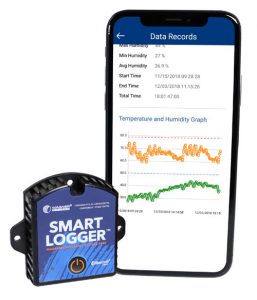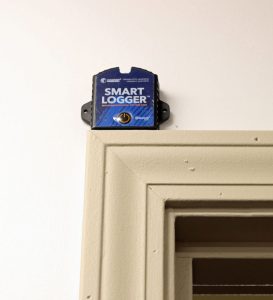Wagner Meters’ Smart Logger™ Data Logs Moisture Risks During Storage or Shipping for Sawmills
Moisture levels in wood are like a moving target. They move up and down from piece to piece or from location to location. After all, wood is a hygroscopic material that easily absorbs and releases moisture depending on environmental conditions until it reaches the final equilibrium.
Sawmills and their customers have to be aware of this natural tendency of wood to absorb and release moisture to avoid problems during storage or shipping. Store wood in a place where it’s exposed to moisture or high humidity and the wood will soon swell. Or, ship wood from a humid environment to one that’s dry, or from a dry locale to a humid one, and problems like the wood warping, splitting or cracking can occur.
For example, a coastal sawmill ships lumber on an oceangoing vessel to a domestic or foreign port. What happens when the vessel’s crew carelessly handles the lumber subjecting it to excess moisture . . . or they store the lumber in the ship’s hold where the humidity is extremely high? This can cause dry lumber to absorb the excess moisture requiring it to either be re-dried or undergo a lengthy period of acclimation before it can be used.
Shipped lumber is always at risk for changes in moisture content. For instance, wood is often shipped by sea in a container. Yet, it can easily absorb moisture if the hold floods or condensation is present. Anytime a cargo of wood is placed inside a steel box, it carries the risk of moisture damage as a result of condensation, or what’s commonly referred to as “cargo sweating.”
Cargo sweating occurs when the surface of the cargo is cooler than the dew point of the air outside the container, causing water droplets to form (condense) on the cooler areas of the cargo itself. Temperature and humidity changes during transit occur from direct solar heating of the hold during the day and cooling at night, combined with high humidity when passing through tropical zones.
But water content in the ship’s hold can also cause condensation/sweating. Typically, moisture is found in timber dunnage and pallets, the wood cargo itself, and even the air inside the hold. When there’s high humidity during loading, that high humidity will also be present in the vessel’s hold.
Moisture problems can also occur when wood is shipped by rail or truck.
That’s why it’s imperative that the sawmill continually monitor the wood’s environment – whether in storage or transit – to avoid any moisture-related problems that can result in wet claims, higher cargo insurance premiums, additional manufacturing costs, additional freight charges for reshipments, lost revenues, and customer-incurred costs such as cancelled sales or delayed fulfillment.
An Innovative Solution

Wagner Meters introduces the Smart Logger ambient temperature and relative humidity data logger which will allow mills to proactively mitigate moisture risks when either storing wood or shipping it to customers.
So how can sawmills easily and cost-effectively monitor wood shipments after they leave the mill? One of the best, most innovative ways is using data loggers.
Data loggers are portable, autonomous data recorders that can be placed aboard ships, trains, and trucks that cannot readily support fixed monitoring equipment. They record the actual times and conditions during shipment so sawmills can identify potentially damaging ambient conditions, such as temperature and humidity.
Industries shipping temperature-sensitive foods, pharmaceuticals, and chemicals use data loggers to monitor their shipment. They’re also used in the lumber industry to measure ambient conditions within storage facilities or dry kilns. And, as already suggested, they can be an effective tool to document environmental conditions during shipping to reveal high-risk stages during their journey by land or sea.
Wagner Meters recently introduced its own portable data logger which allows mills to proactively mitigate moisture risks when either storing wood or shipping it to customers. Called the Smart Logger™, this small, lightweight, portable, and highly accurate device tracks ambient temperature and relative humidity (RH) conditions remotely wherever wood is located – either in storage or in transit.
Simple Operation
The way the Smart Logger works is simple. The mill installs the 2-inch square portable monitoring device wherever wood is stored or in the stack of wood being shipped out.
If sawmill personnel want to monitor a shipment’s environmental conditions during transit to the customer, it sets a logging frequency in the device to start recording data – say every two hours. Once set, the Smart Logger captures temperature and relative humidity information throughout the journey.
Should there be a moisture problem when the customer receives the shipment, he sends the monitor back to the mill. The mill then uses the Smart Logger app to quickly and easily collect data from the device via Bluetooth®.

The Smart Logger is built to be discrete, robust, and accurate with tamper-proof recording of ambient temperature and relative humidity from wherever it’s mounted.
By tracking the ambient conditions, the mill personnel can determine when during transit there were less than ideal environmental conditions that negatively impacted the wood shipment. For instance, it might be determined that the lumber was exposed to high humidity conditions while being shipped – either by rail, truck, or ocean vessel.
After transferring the collected readings to their mobile device, the user can quickly compile the temperature/RH into a report that he can send to the interested parties as evidence of what transpired during shipping.
Operating off of a lithium battery, the Smart Logger can store up to 12,000 pieces of data for up to 300 days. The monitor incorporates the latest Bluetooth technology and works in tandem with the Smart Logger app, which can be downloaded for free at the Apple Store or Google Play. The app connects the Smart Logger monitor to a mobile device via Bluetooth enabling users to transmit and record data, and even send reports via email.
In effect, the Smart Logger can help both sawmill and customer avoid finger-pointing and eliminate breakdowns in their shipping and storage processes. It can also lead to a solution for avoiding the same or similar problems with future shipments.
The result? Fewer dissatisfied customers, less unnecessary product damage or waste, and fewer lost dollars for both parties.
To learn more about the Smart Logger and its ability to benefit users with a variety of applications, call (541) 291-5125, or purchase the Smart Logger online today.
Larry Loffer is a senior technician at Wagner Meters, where he has over 30 years of experience in wood moisture measurement. With a degree in Computer Systems, Larry is involved in both hardware and software development of wood moisture measurement solutions.
Related Posts via Taxonomies
Last updated on December 4th, 2020




This good for construction sites